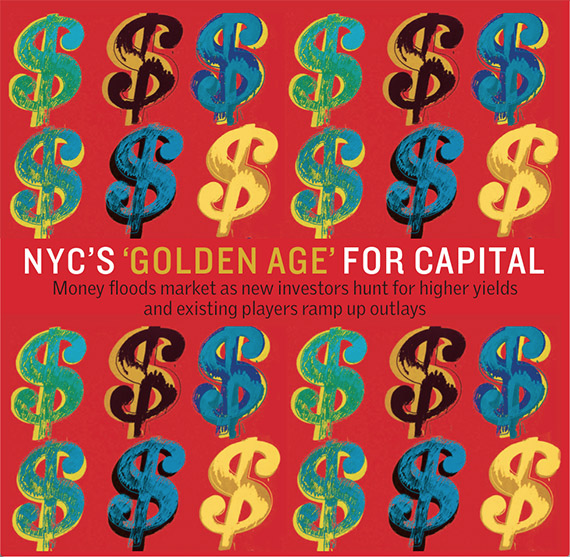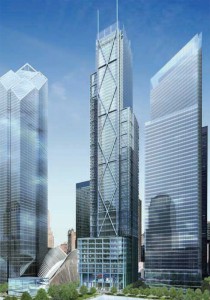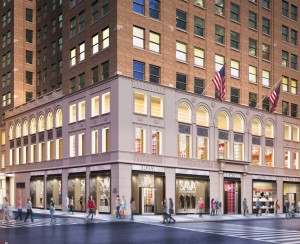
Back in 2009, financing for New York real estate was a rare commodity. Fast forward six years, and developers and lenders say the market is flush with money.
“If I got a multifamily deal and someone needed financing for $100 million, I’d have 50 people fighting over it,” said Jonathan Aghravi, the senior director of the Capital Advisory Division at the commercial brokerage Eastern Consolidated.
Recently, the marketplace for real estate capital has added a number of new players — from crowdfunding platforms to Asian insurance companies — and seen other sources ramping up their financial outlays.
“We’re in sort of a golden age of availability of capital for New York City real estate,” said Scott Singer, president of the Singer & Bassuk Organization, which arranges debt and equity financing. “There are lots of new sources, structuring is very creative and pricing is extraordinarily aggressive. It’s a good time to be a borrower or an owner.”
The economics of why investing in New York City real estate is so popular is straightforward: Low interest rates and low U.S. Treasury yields mean investors are searching afield for profits. Throw in economic instability in many parts of the world, and the strength of New York real estate offers an increasingly compelling upside.
And players are pouring in from all over.
“Banks are still shying away from risky bets,” said Navish Chawla, chief investment officer at the New York-based real estate investment banking firm the Carlton Group. “So you’re seeing capital come from private equity funds, debt funds and other non-traditional lenders.”
Singer pointed out that certain lenders, such as insurance companies and pension funds, have an “absolute need” to generate yields in order to meet their own fiscal obligations. “There’s no yield in money market funds. There’s an extremely low yield in government securities. The stock market is at an all-time high. So the investment options are limited; at the same time, real estate has become a desired, and essentially necessary, component of a diverse portfolio.”
Starwood Capital’s Barry Sternlicht echoed that sentiment publicly in December, citing the growing number of sovereign wealth funds looking to deploy capital here.
“Real estate guys are having to get used to the fact that we’re seeing a lot of strange capital in our market that’s here as a fixed-income investment,” he said.
Below is a look at some of the new players and the shifting landscape for capital in the Big Apple.
Crowdfunding
When brothers Benjamin and Dan Miller launched Fundrise in 2010, they faced little competition from other real estate-focused crowdfunding platforms. Then came the JOBS Act in 2012, which eased federal restrictions on fundraising for small companies. That was a major windfall for crowdfunding firms, which raise smaller amounts of money from a large number of people, typically on the Internet.
Now Fundrise has about 50 competitors nationally in an increasingly, well, crowded space.
In the past year, new entrants have continued to flood the market. And along with everyday investors, institutional players are getting into the game.
For example, the Carlton Group — which specializes in equity and debt placement as well as investment sales — launched its crowdfunding platform in April with a minimum investment of $1 million.
Carlton, which co-invests in each deal, has crowdfunded several big transactions, including $240 million in equity and debt for developer Michael Shvo’s 125 Greenwich Street. Shvo and co-developer Bizzi & Partners paid $185 million for the property. Carlton has another $550 million of deal activity pending, according to Chawla.
While data is hard to come by, crowdfunding platforms have raised more than $65 million in debt and equity for New York City real estate, according to a tally by The Real Deal of publicly cited projects. That’s nearly half the roughly $135 million raised through crowdfunding for real estate nationally, according to an estimate by the Wall Street Journal.
Fundrise has already raised $37 million, including $31 million in 2014 from investors like Chinese tech firm Renren, Ackman-Ziff Real Estate Group and Silverstein Properties. In January, it began offering investors the chance to buy into a $2 million share of the tax-free bonds used to finance Silverstein Properties’ 3 World Trade Center.
And the numbers are growing at a fast clip.
This month, Dave Behin, director of investment sales at residential brokerage MNS, is launching CityFunders with his brother Albert Behin, along with Jerry Swartz, Ayush Kapahi and Jon Harrington, owners of commercial mortgage brokerage HKS Capital Partners. CityFunders will provide crowdfunded equity and loans for New York developments. In a twist, it has obtained a $40 million line of credit so that it can deploy the capital immediately, even before the crowdfunding is complete.

Beyond the sheer number of platforms, the influx of institutional money is enabling crowdfunders to do larger deals, and gives institutional lenders access to smaller projects that they might not have known about.
“They still see lots of deals everywhere, but the technology allows us and them to efficiently access the smaller scale,” said Fundrise’s Dan Miller.
It also allows them to cherry pick deals. “With crowdfunding, investors can pick the specific assets of their choosing, as opposed to investing in a blind pool of money with multiple assets,” said Rodrigo Nino, CEO of the crowdfunding platform Prodigy Network, which secured more than $250 million in funding from 6,000 investors including Deutsche Bank, Bank of America and the Canadian Imperial Bank of Commerce.
Last year, Prodigy raised $75 million for New York projects and Nino said it’s on track to secure $120 million in 2015.
He also noted that crowdfunding opens doors for smaller lenders to invest in big projects.
For developers, crowdfunding offers more financing options.
Developer Brad Korman noted that crowdfunded financing provides “another alternative as we look to grow our portfolio.”
His firm, Korman Communities, has financed some projects through Prodigy’s platform, including extended-stay residences AKA Wall Street and AKA United Nations.
“Frankly, some of the international capital that’s coming in … is giving us, as an operator, a whole other group to talk to,” he said. “That’s how we’ve used crowdfunding, as a partner base for us and deals in New York.”
Still, when it comes to future growth, there are potential roadblocks — such as a market downturn or regulatory changes.
Currently, regulators are looking at the dollar value of assets investors need in order to be an accredited investor; if the threshold is raised, as speculated, to $5 million from $1 million, the pool of potential investors might drop significantly.
“You’re in a new market, with shifting regulatory guidelines,” said Miller. “Right now, it’s almost like the beginning days of e-commerce.”
Asian investment
Where Russian oligarchs once dominated headlines for eye-popping real estate investments, Asian investors have recently swooped in with money to spend.
But while the Russians were paying record prices for lavish pied-à-terres, Asian investors are dropping even more cash on mega commercial assets and development projects.
Just behind Canada, which pumped $3.4 billion into New York City real estate, China ranked as the No. 2 source of foreign capital for New York City real estate last year. Chinese investors spent a whopping $3.35 billion — a roughly $1 billion jump over 2013, according to data from the research firm Real Capital Analytics.
Investors from Singapore, meanwhile, ranked No. 3 with $1.6 billion, followed by Norway with $1.1 billion, Qatar with $770 million and Japan with $680 million.
“It has to do with the state of the foreign economies,” said James Murphy, executive managing director of the investment sales group at Colliers International. Instability abroad makes New York more attractive. “It’s a safe haven.”
With China’s economy slowing, Asian investors are increasingly turning to other markets. Chinese investors, Murphy noted, are making direct buys and taking partial interest in trophy properties. Last year, Colliers created a new 11-person team in Asia, run out of Singapore, in order to “help capital there migrate here.”
Carlton CEO Howard Michaels said foreign investors are moving toward making direct investments in New York projects, rather than putting their money in private equity funds because “they want more control.” During the downturn, he said, many investors were caught in “passive” fund investments that they could not get out of.
“It has more to do with … investors not wanting to be passive and wanting to have more control and say in a project,” said Michaels, who noted that Carlton is currently working on two deals that would bring $2.2 billion in Chinese capital to New York City developments.
But investors’ growing appetite can also be attributed to legislative changes in Asia. Over the past two years, a number of governments — including those of China, Japan, South Korea and Taiwan — have eased regulations that previously prevented life insurance companies from making direct investments in the U.S.
As such, Asian investment in the U.S. is poised to grow, according to commercial brokerage CBRE, which projected that Asian insurance funds would increase their spending on overseas real estate by $75 billion, to a stunning $205 billion in 2018. And New York, of course, is already feeling the impact of the shift.
In addition, China implemented changes that are already being felt here, including increasing allowable investments in other countries to $1 billion from $30 million (with government oversight, of course).
Last year, China’s Anbang Insurance Group picked up the Waldorf Astoria for $1.95 billion, a record sale price in the U.S. for a single hotel.
Investment from Japan — which was going gangbusters in the 1980s, but tanked during the Japanese recession in the 1990s and has mostly stagnated since — has also picked up recently, thanks to companies like real estate giant Mitsui Fudosan.
The Japanese firm, which owns 1251 Avenue of the Americas and 527 Madison Avenue, has said publicly it plans to spend up to $3 billion on Manhattan real estate by 2017. At the end of 2014, Mitsui Fudosan paid $259 million for a 90 percent stake in 55 Hudson Yards, a 1.3-million-square-foot tower going up at 33rd Street and 11th Avenue. The Related Companies and Canadian pension investment firm Oxford Properties are the other owners.
Meanwhile, in January, Japanese real estate investment firm Jowa Holdings paid $210 million for two Madison Square Park office buildings, at 24-28 West 25th Street and 40 West 25th Street. The firm also bought 440 Ninth Avenue, an office building, for $210 million in 2013.
“All of a sudden, we see [the Japanese] companies active again. Folks are actively buying that haven’t for 15 years,” said Mark Edelstein, chair of Morrison Foerster’s real estate finance practice.
The Japanese investment, of course, coincides with heavy Chinese activity in the five boroughs. China’s Greenland Group acquired a 70 percent stake in Forest City Ratner’s Atlantic Yards project, now known as Pacific Park Brooklyn, for a $547 million in 2014. All told, Greenland will put $1.5 billion into the project.
There’s also the Oosten, Xin Development Group International’s 216-unit residential development at 429 Kent Avenue in Williamsburg. Plus, China’s largest residential developer China Vanke and developer Aby Rosen are teaming up on a condo project at 610 Lexington. Then there’s Fosun International’s $725 million purchase of 1 Chase Manhattan Plaza in 2014 and mogul Zhang Xin’s roughly $700 million purchase of a stake in the GM building back in 2013.
Grant Frankel, a managing director at Eastdil Secured, said U.S. prices per square foot are relatively cheap compared to Tokyo, London and Moscow, while financing rates are pretty attractive.
“You are seeing guys looking to diversify out of their countries,” he said. “It’s a global search for yield.”
Bridge loan boom
The strength of the market hasn’t just attracted new lenders, it’s also prompted certain types of lenders to change their ways.
For example, bridge lenders, who provide short-term loans, have been ramping up their investments in New York in the last six months, sources said.
“There’s a feeling in the marketplace among [bridge] lenders that it’s more appealing and the markets are back. There’s more reason to be willing to extend capital in that format,” said John Wilcox, vice president of Marcus & Millichap Capital Corp., the financing arm of the commercial brokerage.
Rising prices in New York have also increased the demand for short-term financing as buyers race to acquire properties.
Eastern Consolidated’s David Schechtman said that in parts of Brooklyn like Bushwick and Greenpoint, where the neighborhood has changed dramatically, borrowers are increasingly using bridge loans to reposition buildings.
“They’re used not just because purchase price has been increased, but because people’s exit strategy has been a quick sale,” he said, noting that there’s been an uptick in property flipping.
The most recent national statistics show that during the third quarter of 2014, close to 22 percent of bank loans for commercial buildings or sites were done with bridge financing, according to a CBRE report.
Eastern Consolidated’s Aghravi said the market’s strength has emboldened lenders willing to make riskier, short-term loans that typically have higher interest rates.
In addition to shops like Aries Capital, (a Chicago-based real estate investment banking firm), lender Mesa West Capital, and private equity group CIM Group (who have been bridge lending for a while), newer players on the bridge-lending scene include Trevian Capital, a Manhattan-based firm launched in 2013, and Thorofare, a Los Angeles-based firm that launched a $400 million bridge-loan fund in September.
In July, Thorofare funded a $28 million bridge loan used by a property owner to buy out a partner in a seven-building portfolio in Brooklyn and the Bronx.
Meanwhile, in January, Cantor Fitzgerald began raising some $400 million of equity for a new bridge-loan fund.
“Some started because there were no other lenders out there,” said Jonathan Stern of Meridian Capital Group.
For example, Manhattan-based Emerald Creek Capital, which launched at the height of the recession in 2009, closed on $200 million in bridge loans last year, including one for $23 million for the acquisition of 50 Clinton Street. In January, the firm launched a fourth capital raise, with a target of $250 million.
Co-founder Mark Penna said bridge lending has been particularly active for the past six months, because the market is bifurcated. “There’s a very narrow group at the top that has access to unlimited money at very low rates,” he said. “For everybody else, it continues to be a long process.”
That’s where bridge loans come in. “The real estate market has been moving and people have been actively buying and selling,” he said. “Time is money; people want to be able to take advantage of opportunities and they recognize a four- to six-month process [for a conventional loan], they might miss an opportunity.”
Penna said Emerald Creek focuses on loans that have specific timing needs. “Regulation is still very constraining to regional, community banks, which is causing traditional financings to take a significant amount of time, even though we’re six years post-Lehman and the height of the crisis,” Penna said. “The conventional path is not the most expeditious.”
EB-5 visas
When Related raised a record $600 million from EB-5 investors for its Hudson Yards development, CEO Jeff Blau called the financing a “critical piece of the puzzle,” and indicated Related would seek more EB-5 funds.
But even as the much-ballyhooed program — which provides U.S. visas to foreigners in exchange for investments in the U.S. economy — has surged in popularity in recent years, its future is unclear.
Unlike the other sources of capital highlighted by TRD, which are flowing more freely into the New York real estate market, there are concerns that the growth of EB-5 financing is hitting a wall.
At issue is how to get around a national cap of 10,000 investors, which was reached for the first time in 2014. In fact, more than 10,000 foreign investors applied for EB-5 visas last year, up from 6,346 in 2013. And more than 80 percent of those applications came from China.
“It’s not that once you reach the quota, the program shuts down. It just causes massive delays,” said Joel Rothstein, an attorney at the law firm Paul Hastings who focuses on EB-5.
To date, the EB-5 program has been something of a silver bullet for a handful of developers.
“Capital is pretty freely accessible, and EB-5 is clearly the elixir du jour in the city,” said Morrison Foerster’s Edelstein. “It’s low-cost capital.”
Launched in 1990, EB-5 began growing in force when the recession hit, as borrowers looked for alternate sources of capital when they couldn’t get traditional financing for deals. The program offers a visa to foreign investors in exchange for a $500,000 investment and the creation of 10 jobs.
As TRD has reported, some of the city’s biggest developers have tapped the program for cash.
Related’s record $600 million financed the construction of foundations at three Hudson Yards towers. Meanwhile, Forest City Ratner has raised more than $475 million for portions of its Pacific Park Brooklyn project and the Durst Organization has raised $260 million for its pyramid-shaped building on West 57th Street and its 375-unit rental tower at 855 Sixth Avenue.
According to members of the EB-5 community, sweeping changes to the program are unlikely.
“Any change is basically tied to the comprehensive immigration reforms in Congress, and I don’t think that will happen soon,” said Rothstein.
However, Rothstein said the EB-5 community is lobbying for alternatives, including an executive order from President Barack Obama to allow investors to tap unused visas from prior years, or to change the way investors are counted so that only investors — not their family members, as is the practice now — would be counted as part of the 10,000.
As it stands, the current visa cap threatens to halt the flow of capital from foreign investors.
“We’re trying to attract investors,” said Laura Reiff, an attorney at Greenberg Traurig, who helps run a group called the EB-5 Legislative Coalition, which is lobbying for changes to the quota “Why would you limit [their participation] arbitrarily? The quota doesn’t make a whole lot of sense.”
The coalition suggests removing the per-country quotas, and administrative fixes to recapture unused visas and funnel unused visas in any government fiscal year. Coalition members include Marriott Hotels and American Hotel and Lodging.
Sovereign wealth
Beyond insurance companies and private funds, sovereign wealth funds — state-owned investment funds — are making a renewed push into New York City real estate.
Starwood Capital, which has $37 billion in assets under management, attracted a number of sovereign funds during a recent round of fundraising, CEO Sternlicht told CNBC in December. “They are screaming for yield,” he said during an interview on Squawk Box. “Look out the window. These buildings, every one of them, is a bond to these investors.”
While sovereign funds aren’t new players on the New York real estate scene, that search for yield is fueling more investment — and in enormous sums.
For example, the Abu Dhabi Investment Authority, with $773 billion in assets, partnered with Related and the Government of Singapore to buy offices at 10 Columbus Circle for $1.3 billion last year.
There are also players making first-time investments in New York.
Last year, Norway’s $884 billion sovereign fund, which first invested in U.S. real estate in 2013, said it would increase its real estate portfolio to the tune of $11 billion. The fund’s investments will be focused in the northeast, specifically in New York, Boston and Washington, D.C.
Norway is fast becoming a top buyer of commercial real estate. “That’s something that’s really come to light in the last 12 months,” said Bob Knakal, founder of Massey Knakal Realty Services and chairman of New York City investment sales at Cushman & Wakefield. “With the ruble in the tank, no Russian investors are being aggressive.”
In 2014, the Norwegian sovereign wealth fund paid $1.5 billion for a 45 percent interest in 601 Lexington. This past fall, the fund reportedly bid $2.2 billion (unsuccessfully) for Blackstone’s 1095 Sixth Avenue. It also holds a stake in 475 Fifth Avenue and 470 Park Avenue South with joint venture partner TIAA-CREF, a pension fund.
Meanwhile, Israel, a longtime source of capital for New York developers, will launch its own sovereign fund next year.
In 2013, the Israeli government approved a sovereign fund to manage the expected windfall from two newly discovered natural gas reserves. The fund is expected to start operating next year.
In the meantime, as TRD has reported, developers have turned to the Israeli bond market to raise nearly $800 million for New York projects.
Gary Barnett’s Extell Development raised $271 million through bond offerings on the Tel Aviv Stock Exchange; Boaz Gilad and Assaf Fitoussi’s Brookland Capital raised $34.5 million; David Lichtenstein’s Lightstone Group raised $120 million, and Abraham Leser’s Leser Group raised $150 million.
CMBS
After grinding to a halt in 2009, the commercial mortgage backed securities market has roared back to life.
Last year’s $13.3 billion in CMBS loans in New York City was more than double the $6.2 billion written in 2012, according to data from Trepp, a real estate analytics firm that specializes in CMBS.
To fully grasp how far the market’s come, there were only $1.1 billion CMBS loans in 2010 and $2.8 billion in 2011.
The increase in CMBS loans, in which pools of real estate loans are bundled together and sold off in pieces, comes as insurance companies and commercial banks ease lending standards.
“When it comes to CMBS, everyone who closed their shop in 2007 has re-entered the market,” said Eastern Consolidated’s Aghravi. “People are just more comfortable with the real estate and the economy.”
Among the big players, Cantor Fitzgerald’s commercial real estate arm, which launched in 2010, originated $10 billion in CMBS loans in 2014, nearly double the $5.5 billion in loans it originated in 2013.
Credit Suisse, whose CMBS shop stopped originating loans in 2008, re-entered the market in 2014 with a $187 million deal for two hotels in Santa Monica, California. And, in January, French bank Societe Generale relaunched a CMBS shop, after winding down its CMBS loan practice in 2008.
Major CMBS deals last year in New York City included the $700 million loan secured by David Werner and Mark Karasick to buy the Mobil Building at 150 East 42nd Street; $1.45 billion for 388-390 Greenwich Street, Citigroup’s headquarters; $900 million for the Grace Building and $750 million for 277 Park Avenue.
Overall, there were nearly $100 billion in new CMBS issuances nationally in 2014. While that’s still less than the record $230 billion in 2007 issuances, it far exceeds 2009, when CMBS loans dwindled to practically nothing. This year, CMBS loans are poised to go even higher, according to Trepp economist Joe McBride, who projected $120 billion to $130 billion in issuances in 2015.
“There’s a high amount of loans maturing in the next three years, coming due from 2005 through 2007,” he said, describing a so-called “wall of maturities.”
McBride said $70 billion in CMBS loans are coming due this year, the most ever, and 2016 and 2017 are expected to see upwards of $110 billion come due.
With an opportunity for many property owners to refinance, he said, “There’s going to have to be a lot of new originations.”




